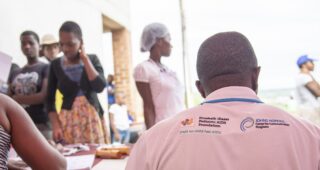HIV 101: Isolating and Discovering HIV
You are here

In 1982, Françoise Barré-Sinoussi, Ph.D. and her colleague Luc Montagnier at the Institut Pasteur in Paris were tasked with analyzing a lymph node biopsy and isolating the agent that was the cause of the new and rare condition called acquired immune deficiency syndrome (AIDS). The team hypothesized that the cause might be a virus, specifically a retrovirus similar to one that had previously identified by U.S. scientist Robert Gallo. As they studied this new sample they looked for the presence of reverse transcriptase activity, the hallmark of a retrovirus.
They observed something that had never been documented before — viral activity occurred as the sample replicated, but at a certain point, the activity stopped and host cells were destroyed. Ultimately, Barré-Sinoussi and her team were able to isolate the cause of the cell’s death, a virus they called the lymphadenopathy-associated virus (LAV). They’d discovered the cause of AIDS.
They reported their findings in 1983, but it took time and additional research to convince the scientific community at-large that the newly discovered retrovirus caused AIDS. Nevertheless, in 1986 LAV was renamed the human immunodeficiency virus (HIV) and the discovery gave scientists a common genesis story for the source of AIDS and a firm starting point for subsequent research.
Isolating HIV opened the floodgates to more discoveries. Researchers began developing HIV tests and treatments, observed the disease progression in clinical trials, and began monitoring CD4 counts (an indicator of how much damage the virus had done). They created combination drug therapies to mitigate drug resistance and developed the first therapeutic approach to prevent mother-to-child transmission of HIV.
Most importantly, they saved millions of lives.
In 2008, the Barré-Sinoussi and her team received the Nobel Prize in Physiology or Medicine for the discovery of HIV. During her laureate acceptance speech, Dr. Barré-Sinoussi acknowledged that though researchers have discovered a great deal about HIV/AIDS, the mechanisms of infection are not entirely understood.
“In the absence of a cure for HIV, it is essential to continue investigating and promoting all prevention measures,” she said in her 2008 acceptance speech. “Although the road is still long, we are on the right path to achieve a world without AIDS."
EGPAF
General



